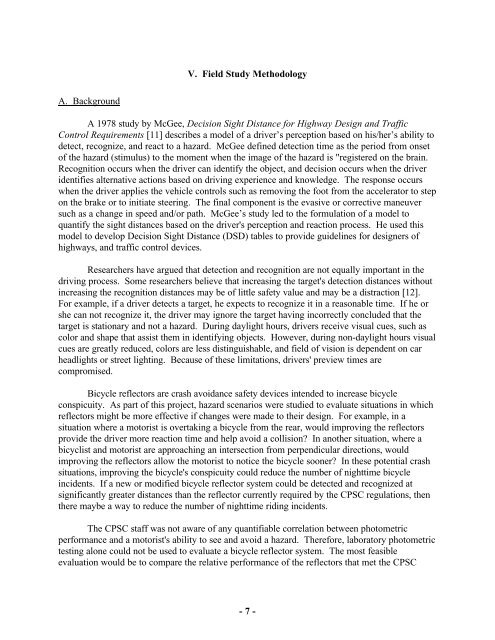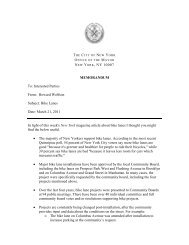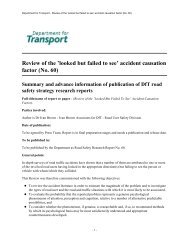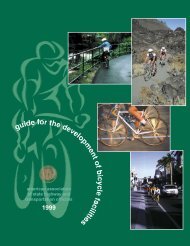Bicycle Reflector Project - Consumer Product Safety Commission
Bicycle Reflector Project - Consumer Product Safety Commission
Bicycle Reflector Project - Consumer Product Safety Commission
You also want an ePaper? Increase the reach of your titles
YUMPU automatically turns print PDFs into web optimized ePapers that Google loves.
V. Field Study Methodology<br />
A. Background<br />
A 1978 study by McGee, Decision Sight Distance for Highway Design and Traffic<br />
Control Requirements [11] describes a model of a driver’s perception based on his/her’s ability to<br />
detect, recognize, and react to a hazard. McGee defined detection time as the period from onset<br />
of the hazard (stimulus) to the moment when the image of the hazard is "registered on the brain.<br />
Recognition occurs when the driver can identify the object, and decision occurs when the driver<br />
identifies alternative actions based on driving experience and knowledge. The response occurs<br />
when the driver applies the vehicle controls such as removing the foot from the accelerator to step<br />
on the brake or to initiate steering. The final component is the evasive or corrective maneuver<br />
such as a change in speed and/or path. McGee’s study led to the formulation of a model to<br />
quantify the sight distances based on the driver's perception and reaction process. He used this<br />
model to develop Decision Sight Distance (DSD) tables to provide guidelines for designers of<br />
highways, and traffic control devices.<br />
Researchers have argued that detection and recognition are not equally important in the<br />
driving process. Some researchers believe that increasing the target's detection distances without<br />
increasing the recognition distances may be of little safety value and may be a distraction [12].<br />
For example, if a driver detects a target, he expects to recognize it in a reasonable time. If he or<br />
she can not recognize it, the driver may ignore the target having incorrectly concluded that the<br />
target is stationary and not a hazard. During daylight hours, drivers receive visual cues, such as<br />
color and shape that assist them in identifying objects. However, during non-daylight hours visual<br />
cues are greatly reduced, colors are less distinguishable, and field of vision is dependent on car<br />
headlights or street lighting. Because of these limitations, drivers' preview times are<br />
compromised.<br />
<strong>Bicycle</strong> reflectors are crash avoidance safety devices intended to increase bicycle<br />
conspicuity. As part of this project, hazard scenarios were studied to evaluate situations in which<br />
reflectors might be more effective if changes were made to their design. For example, in a<br />
situation where a motorist is overtaking a bicycle from the rear, would improving the reflectors<br />
provide the driver more reaction time and help avoid a collision In another situation, where a<br />
bicyclist and motorist are approaching an intersection from perpendicular directions, would<br />
improving the reflectors allow the motorist to notice the bicycle sooner In these potential crash<br />
situations, improving the bicycle's conspicuity could reduce the number of nighttime bicycle<br />
incidents. If a new or modified bicycle reflector system could be detected and recognized at<br />
significantly greater distances than the reflector currently required by the CPSC regulations, then<br />
there maybe a way to reduce the number of nighttime riding incidents.<br />
The CPSC staff was not aware of any quantifiable correlation between photometric<br />
performance and a motorist's ability to see and avoid a hazard. Therefore, laboratory photometric<br />
testing alone could not be used to evaluate a bicycle reflector system. The most feasible<br />
evaluation would be to compare the relative performance of the reflectors that met the CPSC<br />
- 7 -





